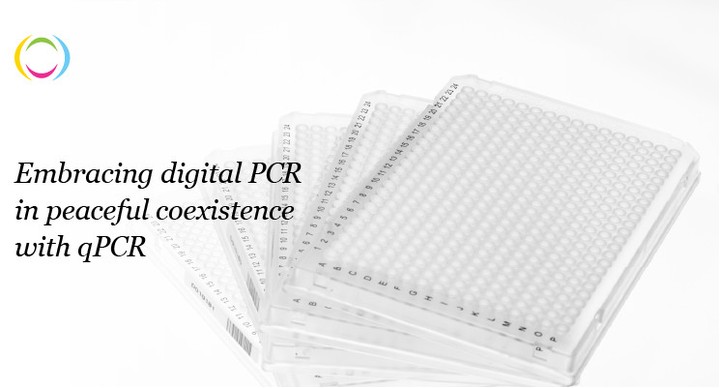Embracing digital PCR in peaceful coexistence with qPCR (EN)
Professor Jo Vandesompele discuss about dPCR and qPCR

How it works
In digital PCR, the template is partitioned into many thousands of miniaturized reactions that contain 0, 1, or a few template molecules. By counting the number of positive and negative partitions (hence the term ‘digital’) at the end of the PCR, it is possible to determine the starting number of template molecules in the sample under investigation. In other words, the question of how much nucleic acid target molecules are present in a particular sample is answered by measuring how many miniaturized reactions are positive if the template is partitioned. Importantly, a Poisson correction needs to be applied on the counts, to correct for the fact that some reactions may contain more than 1 template molecule.
While digital PCR is often perceived as a 2nd generation quantitative PCR technology, it was conceived around the same time as real-time PCR. Only recently, it has come of age due to the availability of dedicated instruments. Being still a relatively young technology, it is important that guidelines have been proposed to setup and validate a dPCR experiment, and to report the results from such a study ( Huggett et al., Clinical Chemistry, 2013, Clinical Chemistry, 2020). These dMIQE guidelines address known challenges identified during the various stages of its development and commercial implementation.
Applications of digital PCR
Given the unprecedented precision, relative sensitivity and accuracy of digital PCR, I see two important application areas for digital PCR, namely gene copy number determination and rare event detection. Digital PCR certainly has advantages for accurate discrimination between higher copy numbers, e.g. 6 from 7 copies, due to its higher resolution, but also for regular gene copy number quantification (1 vs. 2 vs. 3). The great advantage of dPCR is that no specific calibrator samples are required to determine the actual copy number. Nevertheless, it’s good to include both negative and positive controls for quality control purposes.
Rare event detection is useful in the field of cancer gene mutations (diagnosis, monitoring therapy response, early relapse detection), infectious diseases (pathogen detection), genetically modified organism detection in food, and prenatal testing of genetic diseases. In addition to these main application areas, digital PCR can be used in various niche applications where researchers apply creative thinking to come to clever solutions. Once you realize the power of digital PCR, you can imagine various novel applications.
While digital PCR is a very powerful method, I believe that quantitative PCR will remain the mainstay technology for many more years as the user community is large and its most important application domain (gene expression analysis) does not necessarily require the precision and resolution that digital PCR offers.
I believe the trend of cost reduction and higher throughput will continue to occur in the near future. This will allow the technology to be used by more people and in application domains where the advantages compared to e.g. qPCR are not necessarily prominent (e.g. regular gene expression analysis). Another development is the introduction of higher multiplexing capacities. This is relevant as digital PCR in principle lends itself to high multiplexing. Luis Ugozzoli and colleagues were the first to demonstrate true quantitative multiplexing up to 4 targets in a qPCR reaction ( Analytical Biochemistry, 2005). But, as this is the limit for qPCR, most users never try more than 2 targets. As the template is much less complex in a digital PCR reaction, one can image to go way beyond 4 targets, provided the instrumentation enables this level of multiplexing.
To conclude, I want to emphasize that digital PCR holds great promises for clinical applications:
-
same-day results are possible, and data interpretation is quite straightforward; no extraordinary assumptions or heavy computing infrastructure are needed.
-
results can be shared and compared among different laboratories because absolute concentrations are determined
-
the inherently high precision, accuracy, and relative sensitivity are relevant attributes for laboratory tests used in the clinic.
Editor’s note: this post was originally published in May 2013 and has been updated for freshness, accuracy, and comprehensiveness.